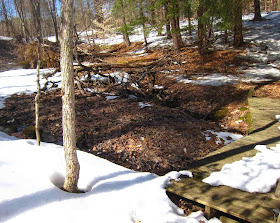Wow! Really balmy today! Forecasts call for temps near 60, can you believe it? It sure didn't feel that spring-like yesterday when I visited Orra Phelps Nature Preserve in Wilton to find the trails still covered in deep snow.
REALLY deep snow, in some spots!
But I was hoping the Skunk Cabbage swale might already be snow-free, and I wasn't disappointed.
And sure enough, this muddy patch was dotted with the fat Morocco-red spathes of Skunk Cabbage (Symplocarpus foetidus), some of which were open enough that I could peek inside.
And look what I found! A spadix already shedding pollen! The first flower of spring is here at last!
Thinking I might find our next flower to open, the American Hazelnut, I drove on up to Mud Pond at Moreau, stopping along the way to gaze at this wide open stretch of the Hudson River. Just look at all that gorgeous blue water and blue sky! Gets your hopes up, doesn't it?
Mud Pond, however, was still frozen over from shore to shore, except where beavers keep the water open around their lodge. But the eastern bank of the pond was mostly free of snow, with a bright afternoon sun warming the path.
Of course, I did not expect to find any flowers opening along this trail, but I did rejoice at the sight of so many beautiful evergreen plants just emerging from the snow cover. Pipsissewa (Chimaphila umbellata) won't bloom until mid-summer, but its shiny green leaves looked as fresh and lovely as ever.
The same could be said for its cousin, the Striped Wintergreen (Chimaphila maculata).
It always amazes me to find the berries of Wintergreen (Gaultheria procumbens) as fat and red (and tasty!) as they were before the winter snows covered them.
The fruits of Partridge Berry (Mitchella repens) were also plump and red, and their foliage such a lovely green.
Fan Clubmoss (Diphasiastrum digitatum) can take the worst that winter brings them, and still they emerge from the snowbanks as sprightly and green as if they were newly sprung from the earth.
After witnessing all that illusory green freshness, of course I was disappointed to find the male catkins of American Hazelnut (Corylus americana) still closed up as tight as they'd been all winter. There will be no hope of finding the tiny red sprouts of the female flowers until those catkins open their scales and start shedding their airborne pollen. But today is warm, and tomorrow will be too. So have courage, my fellow plant nerds, it won't be long!













Hi, I recently found your blog and am thoroughly enjoying it. I went to college up in Vermont and remember how long we had to wait for spring.
ReplyDeleteI was interested in your comment about hazel being the first thing (after skunk cabbage to flower. I just found my first wild one (deep in the woods here in NJ) and was trying to guess when to go back and catch it blooming. Do you find they bloom before maples? what about alders? We've just got silver maples starting to bloom here, is it worth trudging back into the swamp to check the hazel yet, do you think?
Oh, you photo'd several of my favorite winter plants--partridge berry, wintergreen and all those tiny little plants that manage to hold their green color through even the harshest winters. They are all so lovely.
ReplyDeleteNice to find a few plants visible as the snow goes! Hopefully we'll soon be there too.
ReplyDeleteThanks, Sara Rall, for stopping by to leave your comment. I checked my photo files for when I found hazel flowers, and the dates range from late March to mid May up here in northern NY. I have photos of red and silver maples from around those same dates, too. So I would say you should go look for those hazel flowers now, since you live so much further south. Be prepared to peer closely, because they are very small.
ReplyDeleteNice to hear from you, Carolyn and Furry. Yes indeed it was delightful to see that green stuff revealed at last, even though I know it has been there all winter and is not new growth.